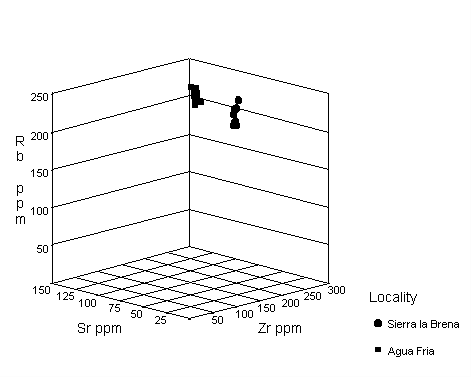
AGUA FRIA, SONORA
Located near the small town by the same name in the Sierra Madre approximately 50 km south of the Arizona/Sonora border, Agua Fria was located as part of the archaeological project directed by John Douglas along the Rio Bavispe and Rio Huachineras. The field relations at the source appear to be typical of Tertiary sources in the North American Southwest as discussed here. Marekanites up to about 5 cm in diameter were located in a rhyolite regolith in low densities around 1 per 400 m2. The glass is black to brown-black, aphyric and vitreous, some with banding, and most are opaque in the thinnest flakes. Although no artifacts were experimentally produced from these nodules, they appear to be an excellent media for tool production. The source, as recorded by Júpiter Martinez, is located on the Mexican INEGI Huachineras H12B87, 1:50,000 scale quadrangle. Collections were made at UTMs 12R 3335935/723111; 3336517/722367; and 3336114/723150. Most importantly here is that only one artifact analyzed from the nearby archaeological contexts could be attributed to this source; nearly the entire assemblage could not be assigned to source (Shackley 2002b). The source itself appears to be chemically diverse, although obviously derived from the same magma source (see Appendix). This is a typical pattern in northwest Mexico; a number of sources are determined by analysis of archaeological contexts, but many are not from sources that have been located nearby (see also Fralick et al. 1998). There are so many sources of archaeological obsidian in this region that distance to source models for the procurement of obsidian become essentially meaningless. While the data for these particular unknown sources will be reported in the future by Douglas, it is important to note that they all exhibit relatively high strontium concentrations, like Agua Fria, ranging between around 100 to 250 ppm. This is quite distinctive and very different from most sources north of the border. Other than Government Mountain and Cow Canyon, the vast majority of sources in Arizona and New Mexico are depleted in strontium and barium relative to rubidium and zirconium (see Appendix and Shackley 1995). This is likely due to the crustal derivation of many of the rhyolite eruptive events in the Sierra Madre. There are no known references for these sources other than some general references made by Bandelier (1892) and later DiPeso (DiPeso et al. 1974).
Agua Fria, Sonora
|
Element |
N |
Minimum |
Maximum |
Mean |
Std. Deviation |
|
|
Std. Error |
Statistic |
|||||
|
Rb |
19 |
208 |
252 |
237.21 |
2.40 |
10.443 |
|
Sr |
19 |
72 |
118 |
88.84 |
2.78 |
12.130 |
|
Y |
19 |
32 |
34 |
32.89 |
.15 |
.658 |
|
Zr |
19 |
158 |
261 |
190.42 |
5.70 |
24.825 |
|
Nb |
19 |
20 |
22 |
21.05 |
.09 |
.405 |
|
Ba |
19 |
454 |
1004 |
619.32 |
31.56 |
137.547 |
The Agua Fria-Sierra la Breņa Relationship
An example that proves the rule is the similarity between the Agua Fria and Sierra la Breņa sources as collected by two archaeologists. These two "sources" are over 40 km distant on either side of the Sonora/Chihuahua state line and are separated by a dissected topography and which, at this point, makes it impossible to determine the genetic relationship. They have nearly identical elemental compositions and presumably are derived from the same magma source (see plot below). This genetic similarity between two or more "sources" at a relative great distance apart appears to be the rule rather than exception in this part of northwest Mexico as detailed by Fralick et al. (1998) and discussed above.

Rb, Sr, Zr plot of Agua Fria and Sierra la Breņa "source" standards. This is similar to the relationships seen commonly elsewhere in northwest Mexico.
![]() Back to SW Obsidian Sources page
Back to SW Obsidian Sources page
Revised: 21 March 2015